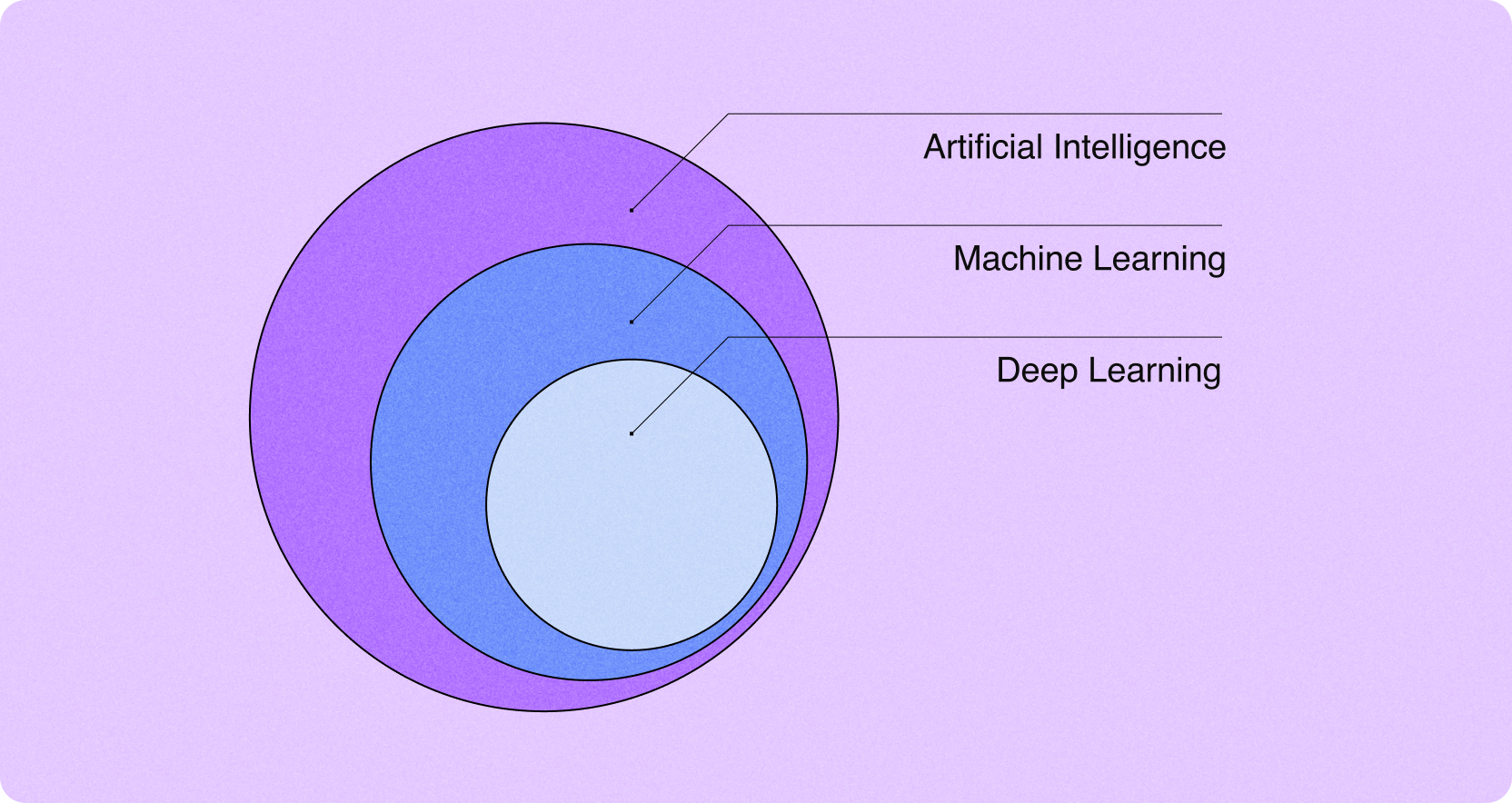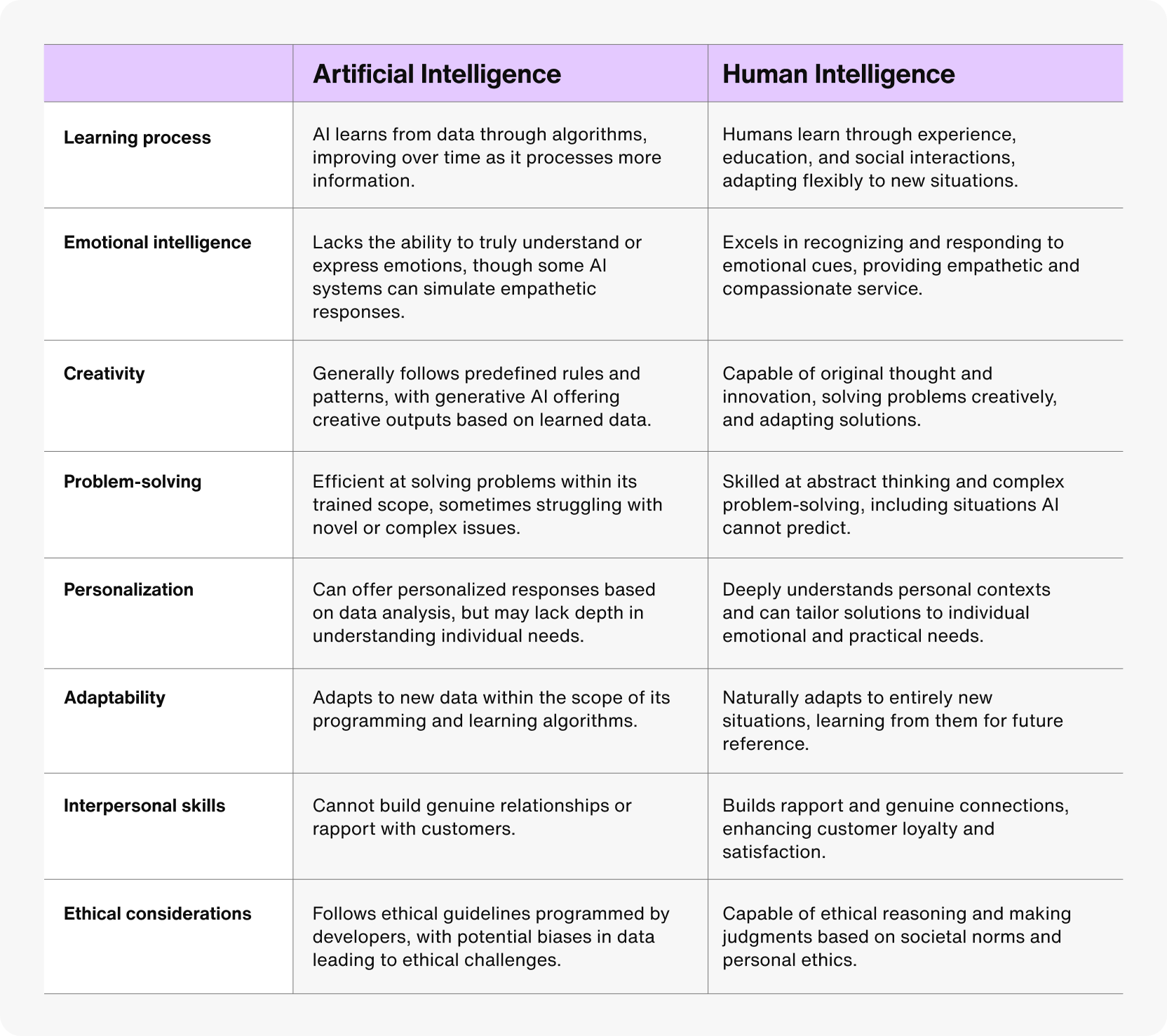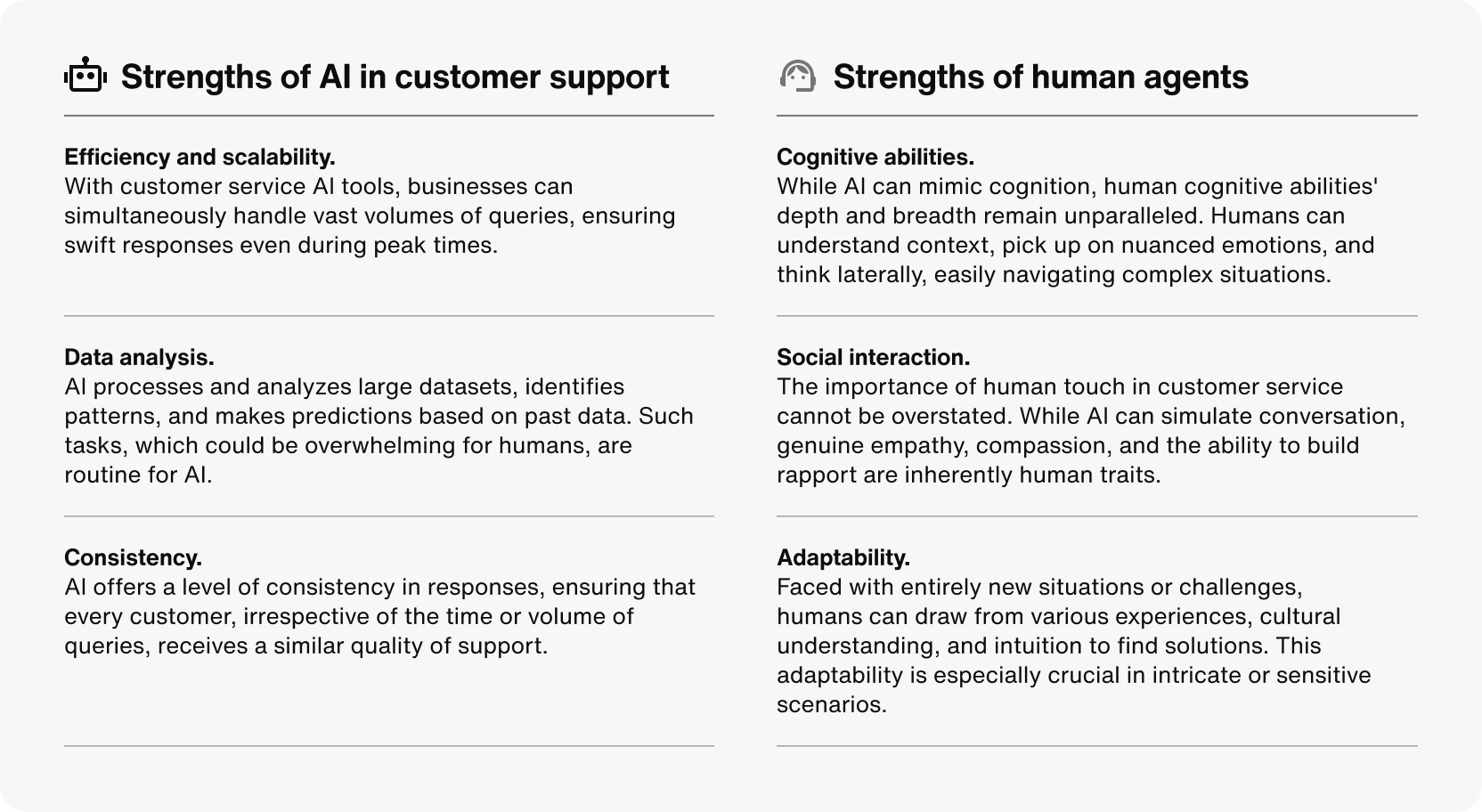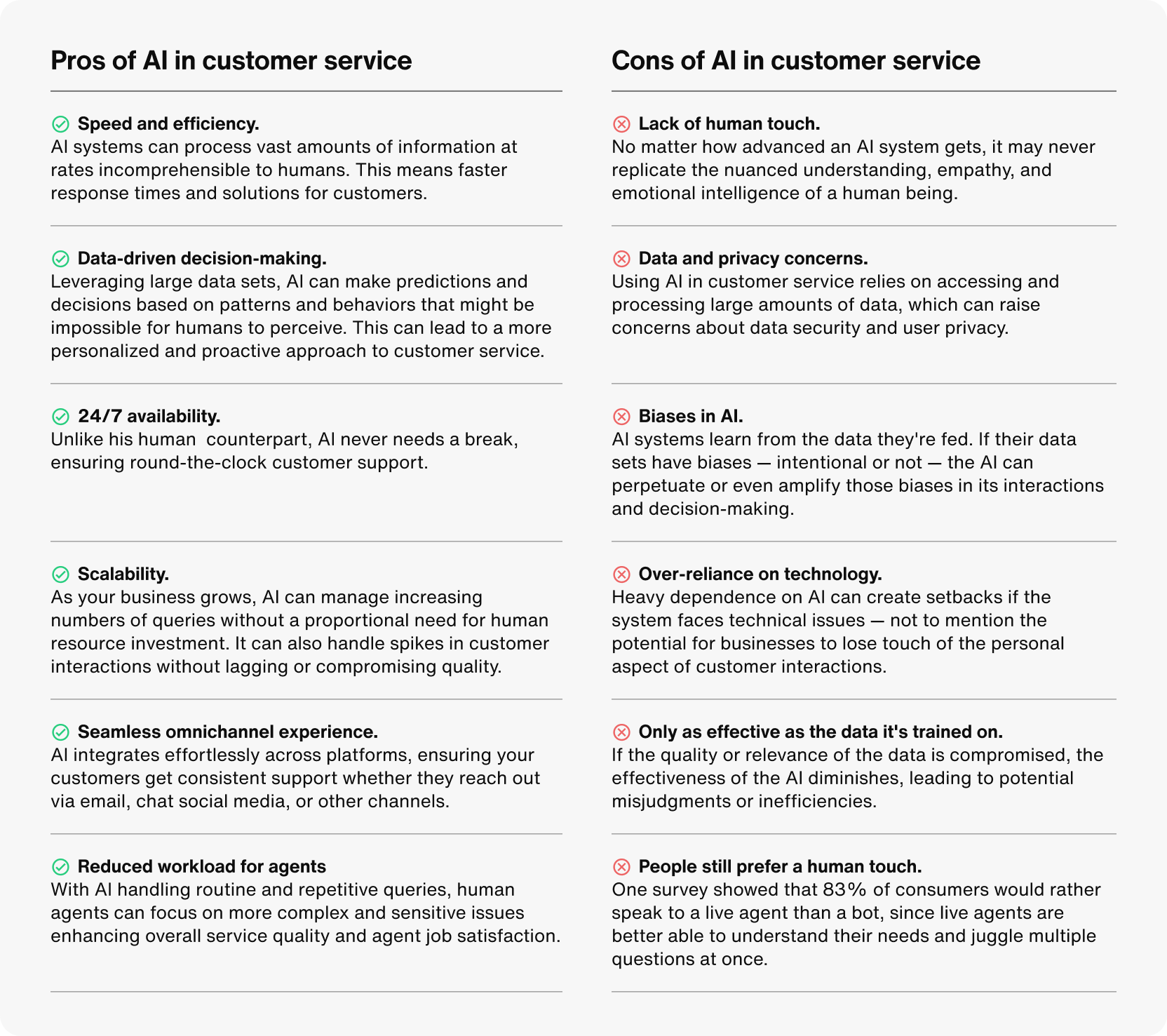AI vs. human agents: How to strike the right balance in AI customer service

AI vs. human agents in customer service AI
In science fiction, humans and the artificial intelligence they create often find themselves at odds. In reality, AI and human agents work together to meld the best of both to create a responsive, personalized customer service experience.
So is it really AI vs. human agents, especially for AI in customer service? For today's businesses, choosing between AI vs. human customer support agents is all about striking the right balance: using AI when customers need fast answers to routine queries and having a human agent step in when customers need empathy, critical thinking, or other skills that no robot can provide.
If you want to learn about balancing AI vs. human agents to build a best-of-both-worlds AI customer service strategy, read on.

8 major support hassles solved with AI agents
AI for beginners: What is artificial intelligence?
Before discussing all the ways AI is—and can be—used in customer service, it's important to understand what AI is and all the different types of artificial intelligence systems that exist.
In other words, machine learning vs. AI vs. generative AI — what do they all mean? And what is DL?
AI, or artificial intelligence, is the broadest of the three terms. Think of it as the tree trunk, with other topics, such as machine learning and generative AI, being the branches. So what is artificial intelligence? AI refers to computer systems designed to mimic human cognitive processes, enabling them to perform tasks that typically require human intellect. These tasks range from simple pattern recognition to complex decision-making processes like the human brain.
Machine learning is a subset of AI. So what is machine learning (ML)? Machine learning (ML) is a branch of artificial intelligence that focuses on the development of algorithms and statistical models that enable computers to perform specific tasks without using explicit instructions. Instead, these algorithms improve their performance by automatically learning and adapting from experience, similar to how humans learn from experience.
A step further in complexity is Deep Learning (DL). What is DL? Deep Learning (DL) is a subset of machine learning that employs artificial neural networks with multiple layers to model complex patterns in data. These deep neural networks attempt to simulate the behavior of the human brain, albeit in a simplified manner, to process data through layers of abstraction and representation. Deep learning techniques excel in handling vast amounts of unstructured data, making them particularly effective for tasks such as image and speech recognition.

Finally, there's generative AI. This is a term for an AI model that can generate entirely new content, whether that's visual art, music, or textual content. You're probably already familiar with generative AI models like ChatGPT, Llama 3, Claude, and Solar.
What is human intelligence?
Unlike AI, human intelligence embodies the complex, multifaceted capability of human beings to learn from experience, adapt to new situations, understand and handle abstract concepts, think of creative solutions to problems, appreciate art, and use knowledge to manipulate their environment.
Human intelligence comes from every individual's unique combination of genetics, experience, upbringing, and exposure to different situations and environments. It's characterized by several key components: emotional intelligence, creativity, problem-solving, and the ability to empathize and connect with others on a personal level.
Emotional intelligence, for instance, plays a pivotal role in customer service, enabling agents to discern and respond to the emotional state of customers, and then offer a more personalized and compassionate service experience.
Creativity, or thinking outside the box, is an especially human trait. is particularly valuable when dealing with new, unforeseen challenges or when a personalized approach is required to satisfy a customer's needs.
Moreover, the human capacity for empathy allows agents to build rapport with customers, understand their concerns on a deeper level, and provide solutions that genuinely resonate with them. This ability to forge emotional connections and offer empathetic support is something that, as of now, AI cannot fully replicate.

Leverage omnichannel AI for customer support
Artificial Intelligence vs. human intelligence
Artificial intelligence and human intelligence both bring their own strengths and weaknesses to the table. Let's take a closer look at some of their fundamental contrasts — and some of the ways they complement one another.

AI vs. human intelligence: How can they work together?
AI and human intelligence can complement each other in many ways. AI excels at handling large volumes of data quickly, performing tasks with precision and at speeds that surpass human capabilities. It can identify patterns and insights within data that might go unnoticed by humans, leading to more informed decision-making.
On the other hand, human intelligence brings to the table the ability to understand context, make nuanced judgments, and navigate complex social interactions. Together, they enable best-of-both-worlds solutions that are not only smart and efficient but also empathetic and contextually aware.
This becomes especially relevant in AI customer service. Here, AI can automate routine tasks, such as answering frequently asked questions or triaging. This not only speeds up response time but also allows human customer service agents to focus on more complex, nuanced issues where human empathy and understanding are irreplaceable.
AI customer service can also act as a copilot, assisting human agents by providing them with relevant information, customer history, and predictive insights, which enables them to provide better, more personalized customer experiences.
There are many ways AI is already being used to improve customer support experiences and outcomes, and many ways it will be used in the future that we haven't discovered yet. So far, though, AI can't handle customer support on its own — there are still plenty of challenges that require human intelligence, and support is at its best when agents are empowered to strike the right balance between AI tools and their own skills.

Empower your support agents with AI
Elements of AI customer service: Is it really AI vs. human in customer service AI?
With those pros and cons in mind, it becomes even clearer that AI customer service isn't about replacing human agents but enhancing their abilities. By merging artificial intelligence with customer service, businesses can achieve a level of optimization previously thought unattainable.
There are many ways businesses are already incorporating AI into their existing customer service strategies:
AI chatbots and virtual assistants: Powered by AI systems and often underpinned by machine learning algorithms, tools like AI concierges and chatbots can handle a wide range of customer inquiries — often without human intervention, delivering rapid and consistent responses with zero downtime.
Predictive analytics: Many companies and customer service platforms can use deep learning to anticipate their customers' needs based on past behaviors, allowing for more personalized and proactive service.
Automated responses and recommendations: Generative AI chatbots can craft instant responses or suggest immediate solutions to elementary problems, providing fast, tailored customer experiences.
Voice and speech recognition: AI-driven systems can transcribe and understand customer voice interactions, helping ensure that customers feel heard and understood.
By leveraging these and other AI systems and tools, businesses can optimize efficiency, accuracy, and personalization in customer service.
The elements below represent some of the ways you can incorporate AI into your existing customer support strategy — not to replace human agents, but to complement them.
GPT-powered conversations
Let's start with a familiar one — GPT. This stands for Generative Pre-trained Transformer. This type of model has been designed to understand and generate human-like text based on the information it's been trained on.
GPT models use a combination of deep learning and vast amounts of data to generate coherent, contextually relevant responses. By training on vast datasets, these models can predict the next word in a sentence and generate full responses to user queries. This makes them highly effective in conversational AI applications, especially chatbots.
There are a few available versions of GPT commonly used in customer support settings:
GPT-2: This was one of the earlier versions that garnered attention due to its impressive conversational abilities. While effective for many basic tasks and general conversations, its successors surpass its capabilities.
GPT-3: With even more parameters and refined training, GPT-3 became a game-changer in AI. It offers more nuanced and contextually appropriate responses, making it an excellent choice for customer service chatbots. Companies using GPT-3 for their support can handle a broader range of customer queries with higher accuracy.
GPT-4: GPT-4 has more refined conversational abilities, better contextual understanding, and more accurate response generation. This version provides even more optimized user experiences and can handle more complex interactions.
GPT-4o: OpenAI's latest model, GPT-4o, was released in May 2024 and offers more precise answers and efficiency compared to previous models. ChatGPT-4o accepts not only text, but also voice, images, and video as input and offers output as text, audio, and images. ChatGPT-4o uses a single model across text, vision, and audio, which means that a single neural network processes input. Response time is also reduced compared to previous models. Token usage has been reduced for non-English languages.
Using GPT-powered chat solutions, businesses can provide customers with immediate, accurate, and human-like responses to common questions. Whether it's troubleshooting issues, answering queries, or guiding them through processes, GPT models offer a reliable and efficient means of enhancing customer support.
Sendbird AI support agents
What is a fast and easy way to use AI to assist your customers through their entire journey? Sendbird's AI customer experience platform.
Use our AI agent builder to deploy a conversational, responsive, multilingual, and always-on AI concierge — the perfect way to increase customer satisfaction and efficiency across all touchpoints.
The AI agent delivers valuable information through engaging experiences with your customers. Then, if customers need more support, the AI agent facilitates a completely seamless handoff to a human agent with summaries of customer interactions.
Create your own AI concierge today to experience a conversation. You provide a web link to the content you want your AI agent to learn, and we'll provide a personalized demo. Contact sales today to see it in action!

Reinvent CX with AI agents
Instant replies
In the fast-paced digital age, the old adage, "time is of the essence," holds truer than ever, especially in customer support. Today's customers expect and appreciate swift responses, and this is where the ability to offer instant replies comes into play.
Instant replies are a pivotal feature of AI-driven customer support tools. They rely heavily on automation to provide customers with immediate answers or acknowledgments. Automated responses can be pre-programmed based on common queries or dynamically generated using advanced AI models.
Here's where instant replies are most useful:
First touchpoint: Instant replies serve as the initial touchpoint for many users, ensuring they aren't left waiting. Even if the AI system needs a few minutes to process a more detailed answer, an instant acknowledgment lets the customer know their query is being addressed.
Handling high volume: Support systems are inundated with queries during peak times or promotional periods. Instant replies ensure every customer is attended to without delays, regardless of the volume of incoming requests.
Consistency and accuracy: Automated replies maintain a level of consistency in responses. Whether it's the 1st query or the 1000th, customers receive uniform quality answers. Moreover, since these replies are based on well-structured data, they tend to be accurate for the questions they're designed to address.
Filtering and escalation: Not all customer queries are the same. Basic questions can be addressed immediately, while more complex issues can be flagged for human intervention. This ensures that human agents are utilized where their expertise is most needed.
Language capabilities
Language capabilities in AI are anchored by a discipline called natural language processing (NLP). NLP allows machines to understand, interpret, and generate human speech and text in a remarkably human-like manner.
With NLP, AI customer support tools can converse in multiple languages. This ensures that businesses can cater to a global audience without the need for multilingual human agents. AI-driven support can also offer real-time translation capabilities. Even if a human agent doesn't speak a particular language, they can still assist customers in that language, with AI translating the conversation in real-time.
But beyond just translation, AI customer service tools grasp the context and nuances of user queries. This contextual understanding ensures that responses are linguistically correct, relevant, and appropriate to the user's concern. Advanced AI models can be trained to understand and incorporate cultural nuances in their interactions, ensuring that the support is linguistically and culturally sensitive.
Incorporating natural language processing and expansive language capabilities into AI customer support platforms breaks down linguistic barriers, ensuring businesses can provide efficient, human-like, and culturally attuned support to every customer, no matter where they are or what language they speak. This epitomizes the transformative potential of AI in creating a truly global and inclusive customer service experience.
24/7 service
AI doesn't need breaks, vacations, or sleep. By integrating AI solutions, businesses ensure that customers can get answers to their questions, troubleshoot issues, or get assistance any time of the day or night.
Maintaining a human workforce for 24/7 service can be prohibitively expensive due to overtime, night-shift premiums, and the need for a larger team. Once set up, AI-driven support can handle unlimited interactions simultaneously, offering substantial cost savings.
Machine learning analysis
Unlike traditional software with static instructions, machine learning allows AI systems to continuously learn from every interaction. This means that the more customers an AI system assists, the better it gets at understanding and meeting their needs.
Machine learning can predict customer needs and concerns based on historical data. For instance, if a product often faces a specific issue after a certain period, AI can proactively provide solutions or advice to customers before encountering the problem.
Intelligent machines use implicit or explicit feedback to refine their operations. For instance, if a solution provided doesn't resolve a customer's issue, the system learns from this and adjusts its future responses accordingly. Machine learning analysis identifies bottlenecks, frequently asked questions, or areas where human agents are most needed. This allows businesses to allocate resources more efficiently and ensure that AI and human agents are utilized to their maximum potential.
Customer self-service platforms
According to the Harvard Business Review, 81% of customers prefer to resolve an issue independently before contacting a customer service agent. Many customers go to forums, search engines, or a company's website for answers — but AI gives companies another avenue for customers who prefer a self-service option.
Chatbots are the perfect way to help customers with specific tasks that don't require an agent, and research shows that AI-powered self-service tools lead to higher customer satisfaction rates, better agent experiences, decreased costs, and even increased revenue.
Agent assist technology
Customer support roles, undeniably, come with their own set of challenges. Agents have to handle a wide spectrum of queries, from mundane to highly intricate. That's why the key to incorporating AI into customer service isn't replacing human agents, but equipping them with AI support tools to enhance their capabilities:
Amplified problem-solving: With the computing power of AI, agents can swiftly navigate through vast databases, fetch relevant information, and come up with solutions faster. This makes addressing complex problems a more streamlined process.
Sector-specific solutions: Take industries like healthcare, for example, where precision and timely access to information can be vital, and AI can assist humans by providing real-time data, suggesting diagnoses based on symptoms, or even recommending treatments.
Training and onboarding: New agents can benefit immensely from AI tools. By observing AI-driven interactions, they can learn best practices, get a feel for the company's approach to problem-solving, and gain confidence in handling customer queries.
Reducing repetition: One of the most taxing aspects of a support role is addressing the same queries repeatedly. By allowing AI to handle frequently asked questions, agents can focus on more nuanced or unique problems, ensuring their skills are put to optimal use.
Decision support: AI can assist agents in making informed decisions by providing them with data-driven insights, predictive analysis, and even potential outcomes based on different choices.

Delight customers with AI customer service
AI vs. human agents: Striking the right balance
By now, we've settled one argument: There's no "artificial intelligence vs human intelligence" in customer support; the focus needs to be on collaboration, not competition. The optimal approach is to harness the strengths of AI and humans, crafting a seamless customer service experience that plays to the strengths of each.

To achieve the best results in customer support, businesses should:
Leverage AI agents for tasks like initial query sorting, instant responses, data analysis, and handling frequently asked questions.
Rely on human agents for scenarios that require deeper cognition, social interaction, or a genuine empathetic response.
By understanding and respecting the unique capabilities of both AI and human agents, businesses can craft a synergistic approach to customer support. It's not about choosing artificial intelligence vs. human intelligence but blending them in harmony to elevate the overall customer experience.
The chatbot to human support handoff
While AI can recognize patterns and keywords, it isn't self-aware. It doesn't have lived experiences or an understanding of the real-world complexities that shape human emotions and behaviors. This is where a human agent sometimes needs to step in to empathize with the customer and provide a more heartfelt, genuine response.
And while AI is great at task-specific functions, multitasking in a human way — juggling empathy, understanding context, and offering solutions simultaneously — isn't within its capabilities yet. Human agents can pivot and adapt to meet customers' needs where AI may fall short.
The goal when bridging the gap between AI tools and human support agents should be to make it as smooth as possible. Recognize that AI has limitations and enable humans to step in when a situation calls for it. Also ensure that the human agent taking over the situation has all the context they need to pick up where the AI left off. This is easily done through ChatGPT-powered summaries.
What does AI vs. human intelligence look like in the future?
AI promises to reshape not just customer service but virtually every aspect of our lives. As we venture further into this future, we can anticipate a world where AI becomes even more integrated into our daily routines, making services more personalized, efficient, and accessible. However, this journey won't be without challenges, particularly concerning ethical considerations, privacy, and the preservation of human touch in an increasingly automated world.
In the near future, AI is expected to evolve from its current capabilities to possess more advanced forms of understanding, learning, and even emotional intelligence. With advancements in machine learning, particularly deep learning, AI systems will become more adept at interpreting complex human emotions and responding in ways that are increasingly indistinguishable from human interactions. This could revolutionize customer support, offering interactions that are not only efficient but also deeply empathetic and personalized.
The integration of AI across different platforms and devices will offer a seamless, omnichannel customer experience. Thanks to predictive analytics and a deeper understanding of individual behaviors and preferences, AI will likely be able to anticipate needs and provide solutions before the customer even identifies a problem.
Despite these advancements, human intelligence will continue to play a crucial role, focusing on creative problem-solving, ethical decision-making, and managing AI systems. Humans will be needed to design, oversee, and improve AI technologies, ensuring they align with ethical standards and societal values. In areas where personal touch and understanding are needed, human roles will become even more important.
Looking ahead, the relationship between AI and human intelligence is set to become more collaborative, with each complementing the other's strengths. The future promises a world where AI enhances human capabilities and service experiences, but it also demands careful consideration of the challenges that come with it. By addressing these challenges head-on, we can ensure that the future of AI and human intelligence is not only innovative but also ethical and human-centered.
How Sendbird powers seamless AI customer service
The incorporation of AI customer support is not about replacing the human touch but amplifying it, ensuring that customers always receive timely, relevant, and empathetic responses. To reiterate, it’s not AI vs. human intelligence; it’s AI and human intelligence.
As both customer support and AI continue to evolve, the role of AI in customer service will surely become even more crucial. But you don't need to be an expert on the future of AI to reap the benefits — you need Sendbird's AI customer experience platform. All you have to do is build an AI agent for it to start handling your customers' queries.
You can also have our sales team help you with any other AI agent integrations or product questions. If you need help, contact us! Our experts are always ready to help.











